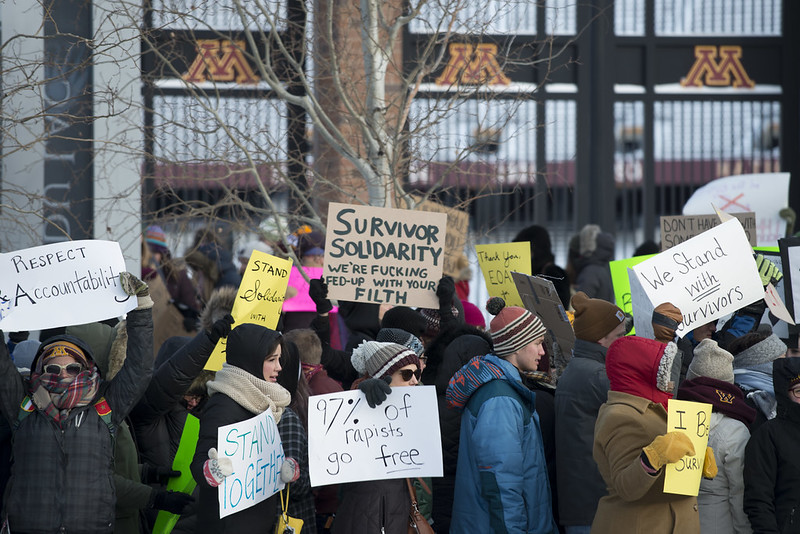Something important has changed in the national discourse about sexual violence, but will it trickle down to those who are most vulnerable?
As a primary care physician who works in a clinic serving low-income and marginalized patients, I am just starting to understand how sexual violence impacts the health and well-being of the women I care for.

One patient I cannot forget is an Eritrean woman—let’s call her Mariam. She was soft-spoken, but in a way that indicated less a personality trait than that something inside her had broken and taken her voice with it. She spoke with effort, as if picking up each word from the back of her throat and pushing it past her lips.
Mariam suffered from chronic pain, and as I probed about her history, the thread of her story slowly unwound until it snagged on a jagged edge and ripped wide open.
She told me about a memory that had festered for decades, eating at her, waking her up at night, seeping into her daily life: She was raped in Eritrea when she was young.
She had nightmares about the rape every night. She talked about the shame of it, how she became pregnant from the rape and now had a teenage son whom she would never tell; how she cried often and he never knew why; how he asked her about his father and she didn’t know what to say; how she didn’t know how to bridge this distance between them. She told me she was depressed every second of every day; that life was hard to live.
I was angry that this had happened to her, and I wanted to tell her she was safe here. But then I remembered the time I was grabbed by a stranger, shoved to the ground and almost raped. I remembered screaming while he held me by the wrists and told me to shut up before he suddenly got up and left me lying there. This country is not safer; I was just luckier.
In America, one in five women will be raped at some point in their lives (although men can also be victims of sexual assault, over 90 percent of rape victims are women). The majority of these assaults will not be reported to the police.
A much greater number of women have experienced less “visible” forms of sexual violence such as coercion, reproductive control or unwanted advances.
Women who have been raped report worse physical and mental health in multiple areas, according to global data compiled by The International Society for Traumatic Stress Studies. Post-rape health problems range from substance abuse to gastrointestinal disorders to decreased use of preventive health services. These changes can persist for years.
In medicine, we use the concept of “triage” to identify those most in need and devote more resources to their care—yet our system does the opposite when it comes to victims of sexual violence. Women who are undocumented immigrants, who are poor or who have dependents have both a higher risk of being targeted and fewer resources for legal and medical help.
In 2017, the Bureau of Justice Statistics reported that women who live in poverty are twelve times more likely to be sexually assaulted or raped than women who make over $75,000 a year.
Studies also show that many women report being re-traumatized by the medical and legal systems from which they seek help, and therefore may be reluctant to share this vital part of their medical history.
Unfortunately, there are scant data to guide practice and few resources to give patients. The U.S. Preventive Services Task Force—the national expert panel for preventive care—recommends screening women of childbearing age for intimate partner violence, but clinics implement screening at their own discretion. The number of people affected by sexual violence is 2.5 times the rate of cardiovascular disease, cancer, diabetes and HIV/AIDS combined—yet public funding for all forms of violence, including sexual violence, is a tiny fraction of total NIH funding (0.001 percent) compared to these other diseases (29 percent).
After Mariam, I learned how to screen for domestic violence and sexual abuse. As I started asking different questions, I heard stories that made me realize the profound scope of the problem. I asked women who hadn’t had pap smears in many years if they had any fears about the procedure, and I found a history of rape. I asked patients who had chronic pain without an anatomic cause, and more often than not I found a history of abuse. I witnessed how trauma can hide away in a person’s body like a latent virus. When triggered, it crawls out from dark recesses and wreaks havoc on its host: It twists muscles, grinds bones, squeezes air from lungs.
But I also found resilience. Every day in my clinic, I meet women who find strength in themselves and in their community, and find ways to build themselves back up. I see in my patients a steady resolve and, more often than not, a desire to help other women survive what they have been through. I see true courage.
Harvey Weinstein’s conviction is a step in the right direction, but it took powerful, well-resourced women to take down Mr. Weinstein. In order to end the epidemic of sexual violence, we need to invest in research and to support all survivors by creating evidence-based programs to help them to lead full, healthy lives.
You may also like:





